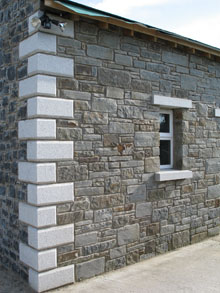Wilderhope Manor is a 16th-century Elizabethan manor house in Longville in the Dale, Shropshire, seven miles (11 km) southwest of Much Wenlock, on the limestone escarpment known as Wenlock Edge.
The Grade I listed building, now in the ownership of the National Trust,[1] has been used as a youth hostel since 1937, managed by the Youth Hostel Association. The adjoining stable block is Grade II listed.[2]
The house was built for Francis Smallman, whose initials can be seen in cartouches in the hall ceiling.[1] The manor remained in the family until 1734, when the estate including the neighbouring Wilderhope farm was sold to Thomas Lutwyche. It is believed that the manor house was not subsequently used as a main residence, and fell into a poor state of repair.[3] Restored by John Cadbury in 1936,[4] it was donated to the National Trust the following year, to be used as a youth hostel.[5]
Architecture
The manor house is in limestone with dressings in gritstone, quoins
Any external angle or corner of a structure., hood moulds, copings and finialsDecoration marking the top end of some architectural element such as a gable, newel post or fence post. on the front, and a stone-slate roof. There are two storeys and attics, and an approximately H-shaped plan. The entrance front has six bays and four unequal gables, three of them over projecting bays, in the left of which is a porch. The windows are mullioned and transomed, and at the rear there is a semicircular stair turret with a conical roof.[1][6]
The stables, now used as a field-study centre, are in brick with a storey band, and have tile roofs with parapeted gables. They have a single storey and lofts, and a U-shaped plan with a main range of three bays. The windows are casements with segmental arches, and there are doorways and loft openings.[2][6]
Interior
Most walls have exposed square panelled framing and decorative plastered ceilings. The parlour ceiling is particularly elaborate, with star-shaped ribs and motifs, and is dated 1601. The hall has a large Tudor-arched fireplace, and the upper rooms also contain fireplaces.
Major’s Leap
During the English Civil War (1642–1651) the manor was home to the Royalist supporter Major Thomas Smallman. Forced to flee from Oliver Cromwell’s approaching Parliamentarian troops, he escaped on horseback and took a do-or-die plunge down a steep slope at Wenlock Edge. His horse was killed, but Smallman survived thanks to an apple tree breaking his fall. Since then the ghosts of Smallman and his horse are said to appear in an area now known as Major’s Leap, and have reportedly been seen at the manor.[7]



